As an Amazon Associate KitchenwareSets.com earns from qualifying purchases.
9 Effortless Farmhouse Kitchen Ideas You Need To Try
Are you dreaming of a kitchen that feels less like a sterile workspace and more like the warm, beating heart of your home? A place where family gathers, conversations flow, and memories are baked right in alongside the bread. So many modern kitchens can feel cold or impersonal, leaving you with a space that’s functional but lacks that essential, soul-soothing charm. You might be scrolling through endless photos, wondering how to capture that cozy, lived-in feeling without committing to a style that will feel dated in a few years.
This is a common struggle. You want character, but you also need clean lines. You love rustic touches, but your home is more contemporary. The fear of choosing the “wrong” style, especially for a project as significant as a kitchen, is real. You’re looking for a design solution that feels both personal and timeless, a perfect blend of comfort and sophistication. How do you bridge the gap between the charm of the past and the clean sensibilities of today?
The answer lies in the modern farmhouse kitchen. A modern farmhouse kitchen blends rustic charm with contemporary conveniences, focusing on natural materials, a neutral color palette, and practical, vintage-inspired elements. It’s the perfect formula for creating a warm, inviting, and highly functional space that remains stylish and timeless, effortlessly adapting to your life.
Dreaming of a Cozy Kitchen? Here’s How Farmhouse Style Delivers Timeless Charm
The enduring appeal of a farmhouse kitchen lies in its ability to create a warm, charming, and genuinely inviting atmosphere. It’s a style rooted in practicality and comfort, where every element feels both beautiful and purposeful. Unlike fleeting trends that can make a kitchen feel outdated, the modern farmhouse aesthetic updates this classic look with cleaner lines and contemporary conveniences, ensuring it feels fresh and relevant for years to come. It masterfully solves the problem of a cold, impersonal kitchen by grounding the space with natural textures and a sense of history.
As a design strategist, I’ve seen styles come and go, but the core principles of farmhouse design—warmth, functionality, and natural beauty—remain consistently beloved for a reason. It’s more than just a look; it’s a feeling. It’s the perfect solution for anyone wanting to transform their kitchen from a simple cooking area into the true heart of their home. Below, we’ll explore nine foundational ideas that will help you capture this timeless appeal in your own space.
9 Effortless Farmhouse Kitchen Ideas You Need To Try This 2025
Ready to infuse your kitchen with character and warmth? These nine straightforward and impactful ideas are the building blocks of a modern farmhouse kitchen. We’ve curated these core concepts by analyzing hundreds of successful designs, focusing on the elements that provide the most impact for your effort. The beauty of this style is its flexibility; you can mix and match these ideas to perfectly suit your personal taste, the size of your space, and your budget. Whether you’re planning a full remodel or just a weekend refresh, these tips will guide you in creating a kitchen that is both beautiful and deeply personal.
1. Embrace a Calming, Neutral Color Palette
The foundation of a classic farmhouse look begins with layering neutral colors to create a serene and versatile backdrop. A neutral color scheme, featuring shades of white, cream, gray, and other earthy tones, provides a calming and stylish canvas. This allows the natural materials and unique decor in your kitchen to truly shine. Far from being boring, a neutral palette offers incredible depth and sophistication when done correctly.
This approach makes it easy to introduce pops of color through accessories that you can swap out with the seasons. For instance, deep, rich colors like a dark green or a moody blue-gray can be used on lower cabinets or a kitchen island to add visual interest and ground the space. Meanwhile, accent colors like navy blue, ruby red, or sage green can be incorporated through dishware, linens, or wall decor. The ultimate goal is to create a layered look with subtle variations in tone.
Actionable Steps:
- Materials Needed: Paint swatches (e.g., Benjamin Moore’s White Dove, Sherwin-Williams’ Alabaster), painter’s tape, sample pots of paint.
- Step-by-Step Directions:
- Select Your Base: Choose a primary neutral, like a warm white or a soft cream, for your walls and upper cabinets. This will create a bright, airy foundation that makes the space feel larger.
- Add Depth: Consider a slightly deeper, complementary neutral—think greige or a soft mushroom color—for the lower cabinets or a central island. This technique adds visual weight and interest without overwhelming the room.
- Test in Your Light: Tape your paint swatches to different walls within your kitchen. Observe them at various times throughout the day to see how they interact with your home’s natural and artificial light sources.
- Plan Your Accents: Decide on one or two accent colors, such as sage green or navy. Plan to introduce these through easily changeable items like textiles, pottery, copper pots, or other decor.
Pro-Tip: Don’t be afraid to mix different shades of white and cream. Layering these tones adds a sophisticated depth that a single shade can’t achieve, preventing the space from feeling sterile or one-dimensional.
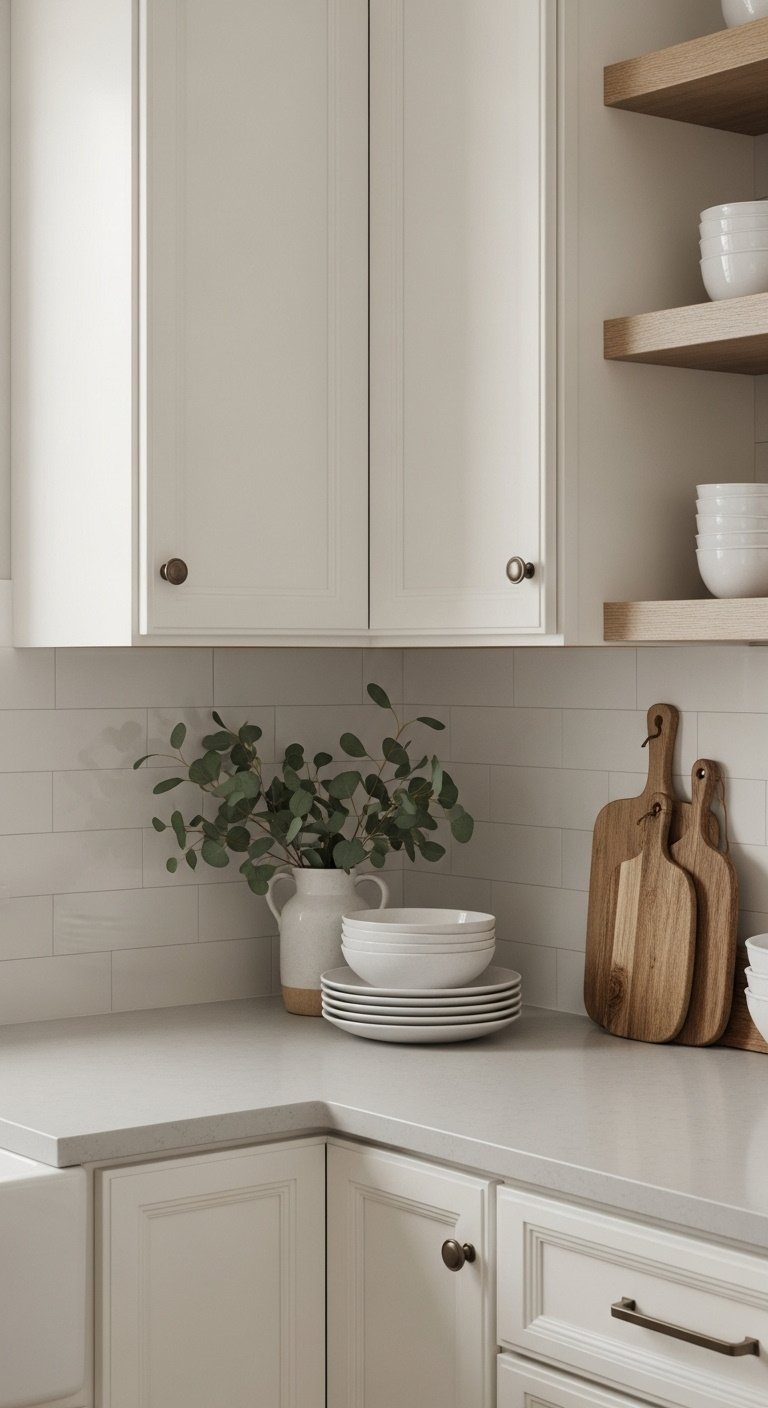
Pin this color inspiration for your modern farmhouse kitchen!
2. Layer in Natural Materials for Warmth and Texture
To achieve an authentic farmhouse feel, you must incorporate natural materials to add warmth, texture, and character. These elements are fundamental to the aesthetic, connecting your kitchen to the natural world and giving it a sense of history and authenticity. Wood, stone, brick, and natural fibers work together to create a tactile and visually interesting environment that feels both rustic and refined.
Wood is incredibly versatile and can be used in various forms, such as rich hardwood floors, dramatic exposed ceiling beams (whether real or faux), practical butcher block countertops, or handsome natural wood cabinetry. Reclaimed wood, in particular, is a fantastic choice as it adds a unique story and character to the space. Stone and brick also play a vital role. Natural stone countertops, like soapstone or marble, offer an organic and classic feel. Exposed brick or a brick veneer can be used for a stunning backsplash or an accent wall, providing unparalleled warmth and texture. Finally, don’t forget the softer touches: woven baskets for storage, jute rugs underfoot, and linen curtains on the windows all contribute to the cozy, natural atmosphere.
Actionable Steps (DIY Reclaimed Wood Shelf):
- Materials Needed: Reclaimed wood plank (for a shelf), shelf brackets (matte black), level, drill, screws, stud finder.
- Step-by-Step Directions:
- Source Your Wood: Find a beautiful piece of reclaimed wood from a local salvage yard or an online retailer. Lightly sand it to remove any large splinters but be careful to preserve its unique character and patina.
- Locate Studs: Use a stud finder to mark the location of the wall studs where you plan to hang your shelf. This step is absolutely crucial for ensuring the shelf is stable and can hold weight.
- Install Brackets: Secure the shelf brackets to the wall, driving the screws directly into the marked studs. Use a level to ensure they are perfectly straight and aligned with each other.
- Attach Shelf: Place the wood plank on top of the brackets and secure it from underneath with screws. Style your new shelf with stoneware, plants, or your favorite cookbooks.
Lesson Learned: When choosing butcher block countertops, opt for end-grain for durability in high-use areas, but edge-grain is perfectly fine and more affordable for islands or less-used surfaces. Always seal it with a food-safe oil to protect the wood and keep it looking its best.
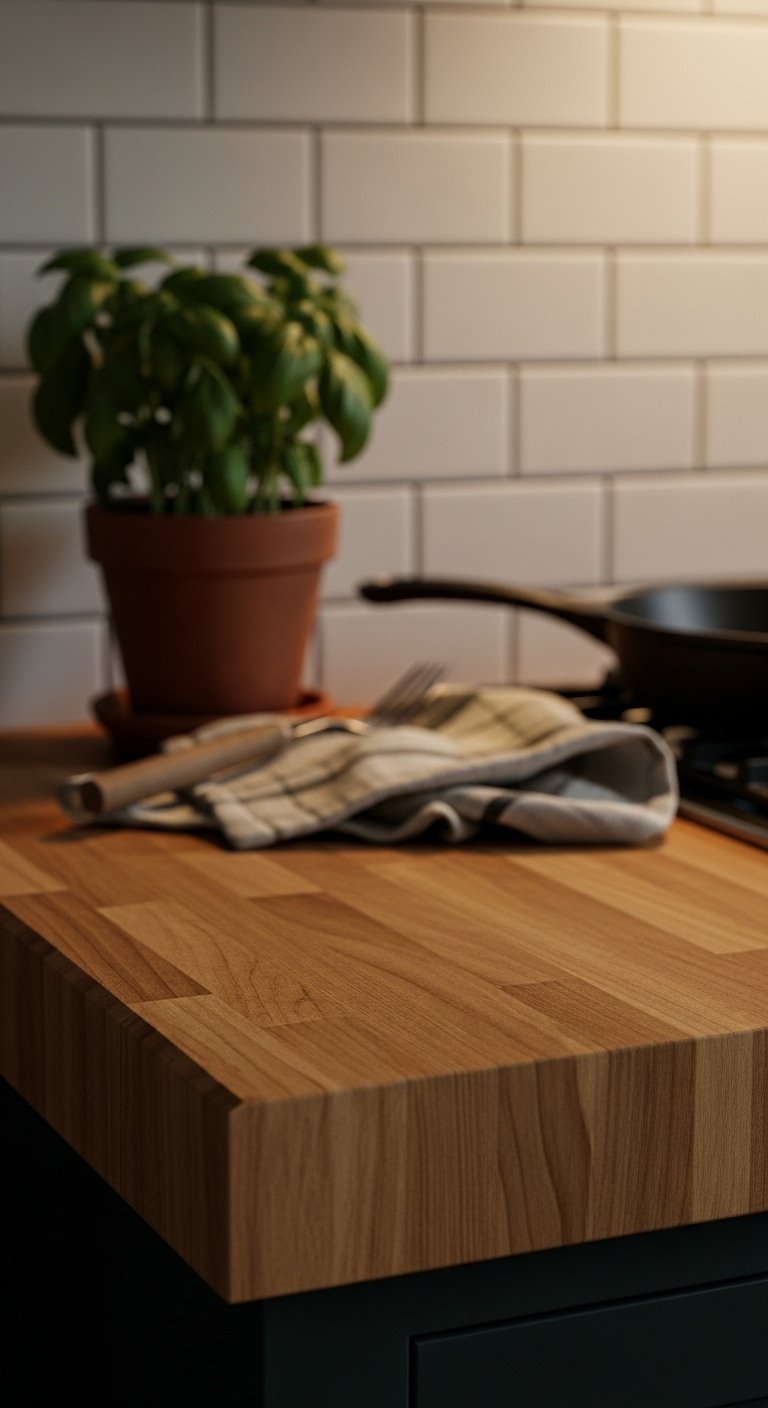
Save this to your ‘Dream Kitchen Textures’ board on Pinterest!
3. Make a Statement with a Classic Farmhouse Sink
Perhaps the most iconic element of this style is the farmhouse sink, which serves as a beautiful focal point while offering incredible practicality. Often called an apron-front sink, this quintessential feature immediately signals a farmhouse aesthetic. Its exposed front and deep basin are not only charming but also highly functional, making it easy to wash large pots, pans, and baking sheets that won’t fit in a standard sink.
These sinks are available in a variety of materials that enhance their vintage feel. Fireclay is the most common choice, celebrated for its classic look and exceptional durability. Cast iron offers a similar aesthetic with a high-gloss finish, while materials like copper or even natural stone can be used to create a more dramatic, rustic statement piece. No matter the material, a farmhouse sink elevates the entire kitchen design.
Actionable Steps (Choosing Your Sink):
- Materials Needed: N/A (This is a selection guide).
- Step-by-Step Directions:
- Choose Your Material: Fireclay is the classic choice, known for being highly durable and resistant to stains and chipping. Cast iron provides a similar look with a glossy finish. For a bold, rustic statement, consider a sink made from copper or soapstone.
- Consider a Single vs. Double Basin: A large, deep single basin is perfect for washing oversized items like stockpots and cookie sheets. A double basin offers more versatility for multitasking, allowing you to wash on one side and rinse or prep on the other.
- Measure Your Cabinet: This is critical. Apron-front sinks require a specific type of base cabinet that is cut to accommodate the exposed front. Ensure your measurements are precise before you order the sink or have your cabinets built.
- Pair with the Right Faucet: The scale and style of a farmhouse sink demand a complementary faucet. A high-arc gooseneck faucet provides ample clearance, while a vintage-style bridge faucet perfectly enhances the classic aesthetic.
Pro-Tip: To protect the bottom of your fireclay or cast iron sink from scratches and chips from heavy pots, invest in a stainless steel basin grid. It’s a small cost that significantly extends the pristine look of your sink and is one of my must-have recommendations for clients.
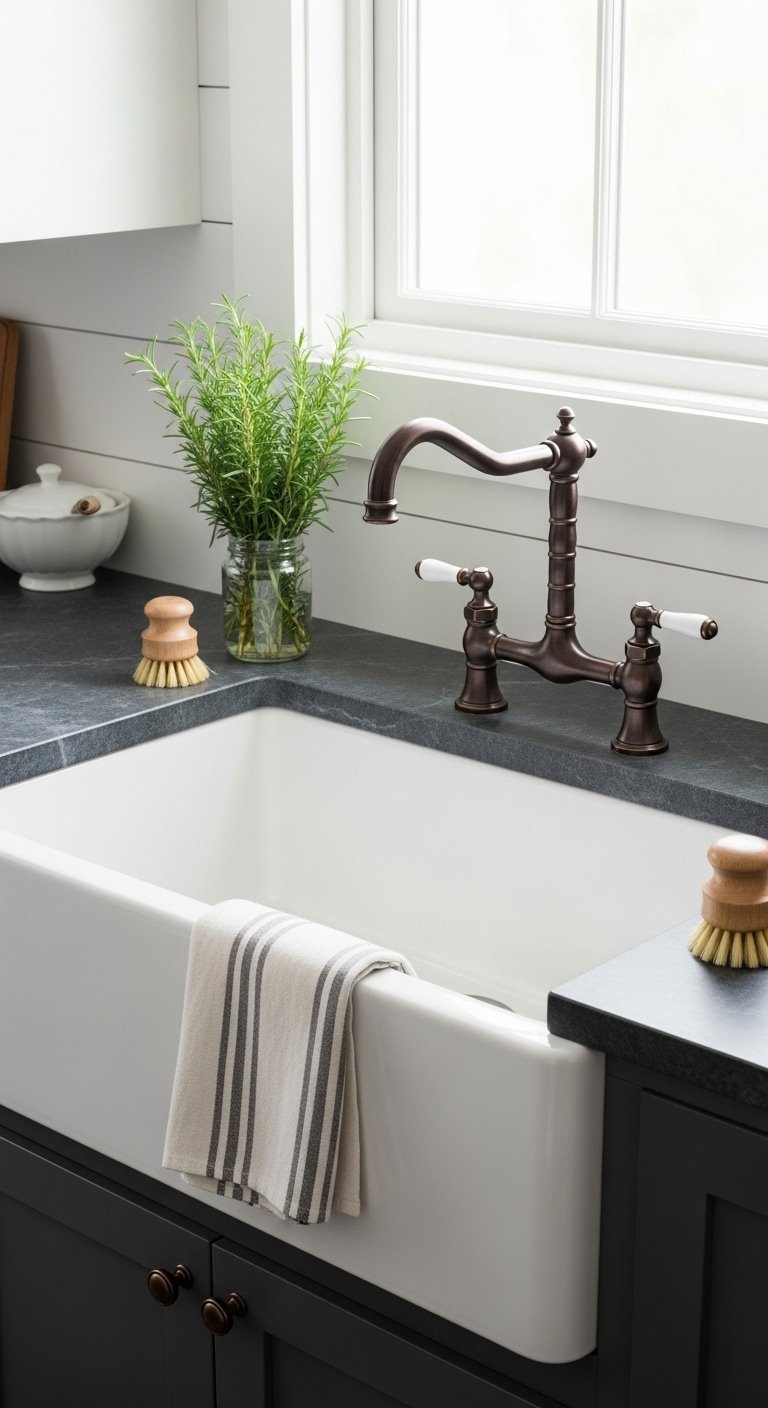
Love this look? Pin it to your ‘Kitchen Remodel’ board!
4. Mix Shaker Cabinets with Open Shelving
The ideal storage solution in a farmhouse kitchen is a balance between simple, clean-lined cabinetry and airy open shelving. Shaker-style cabinets are the go-to choice, embodying a timeless and unpretentious look that is the hallmark of farmhouse design. Their simple frame-and-panel construction provides clean lines that work beautifully in both traditional and modern interpretations of the style.
To add visual interest and prevent rows of upper cabinets from feeling too heavy or monolithic, consider replacing a few of them with open shelving or cabinets with glass-front doors. This strategy breaks up the visual weight and creates an open, airy feeling. Open shelves are the perfect spot for displaying your everyday dishes, vintage finds, cookbooks, or decorative items. This not only adds personality but also makes the space feel lived-in, accessible, and welcoming.
Actionable Steps (Replacing Uppers with Open Shelves):
- Materials Needed: Crowbar, drill/driver, wood filler, sandpaper, paint/primer, floating shelves with hardware.
- Step-by-Step Directions:
- Carefully Remove Cabinets: First, empty the cabinet you wish to replace. Use a drill to unscrew the doors. Then, carefully locate and remove the screws holding the main cabinet box to the wall and to any adjacent cabinets.
- Patch and Paint: After the cabinet is removed, fill any screw holes in the wall with wood filler. Once it’s completely dry, sand the area smooth and apply a fresh coat of primer and paint to match the rest of your wall.
- Install Floating Shelves: Follow the manufacturer’s instructions to install your new open shelves. Always ensure they are perfectly level and securely fastened into wall studs for maximum support.
- Style Thoughtfully: Arrange your everyday dishes, glassware, and a few decorative items on the shelves. The key is to avoid overcrowding. Leave some negative space to maintain an airy and uncluttered feel.
Pro-Tip: When styling open shelves, I always tell my clients to group items in threes or fives. Mix heights, textures, and shapes for a dynamic display. For example, place a neat stack of plates next to a taller vase and a small, leaning cutting board for a perfectly balanced look.
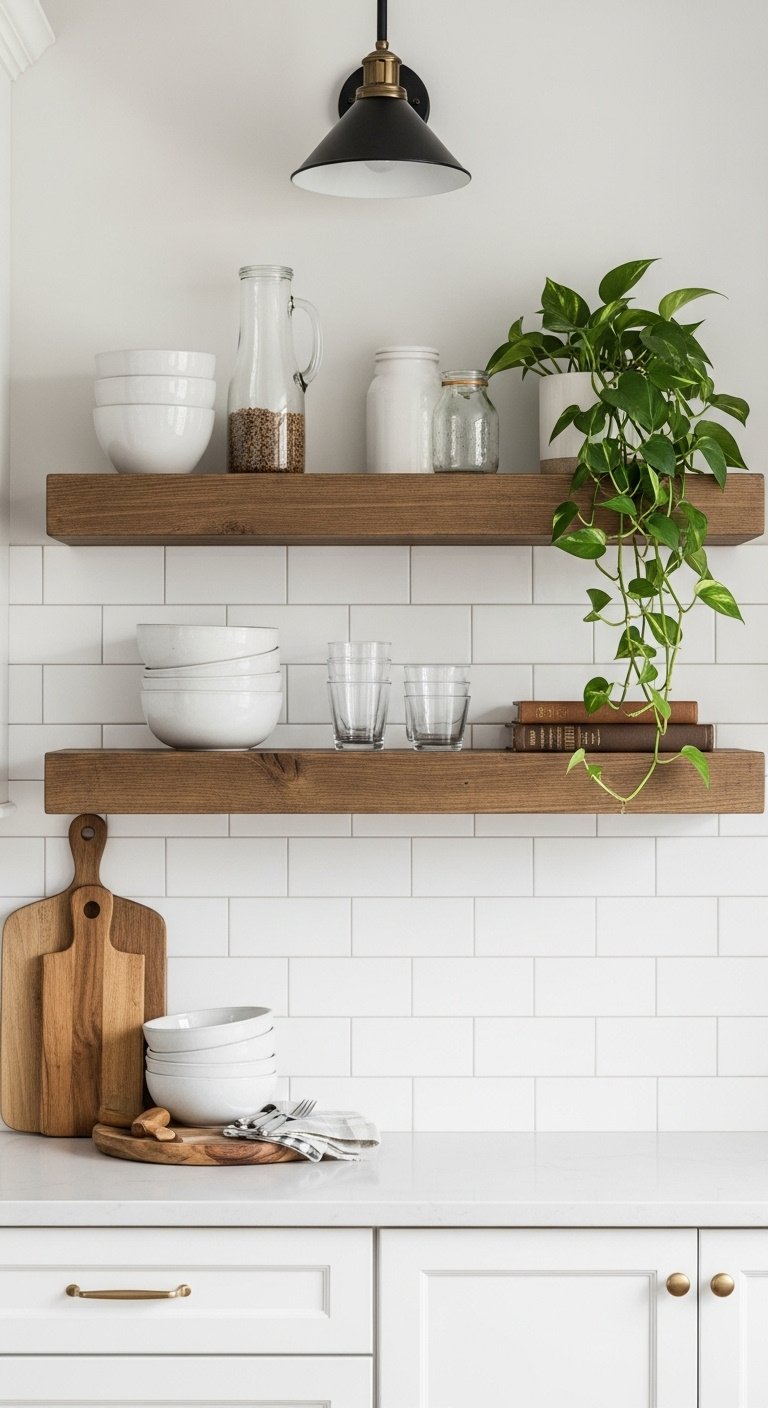
Click to save this airy and organized shelving idea!
5. Choose Vintage-Inspired Fixtures and Hardware
In farmhouse design, the small details matter immensely, and the right hardware can complete the look by adding a layer of vintage or antique-inspired charm. Think of fixtures and hardware as the jewelry of your kitchen. Selecting faucets, cabinet hardware, and lighting that have a nostalgic feel is crucial for achieving an authentic look.
Finishes like matte black, oil-rubbed bronze, or brushed nickel are popular choices for hardware. These provide a subtle yet beautiful contrast against neutral-colored cabinetry. For lighting, consider pendant lights, sconces, or even a statement chandelier made from character-rich materials like wrought iron or wood. These pieces add not only functional light over islands and sinks but also a significant dose of personality.
Actionable Steps (Updating Cabinet Hardware):
- Materials Needed: New cabinet hardware (knobs/pulls), screwdriver, template tool (optional, but highly recommended).
- Step-by-Step Directions:
- Measure First: If you are replacing existing hardware, measure the distance between the screw holes (from center to center) on your current pulls. This ensures the new hardware will fit without you having to drill new holes.
- Remove Old Hardware: Use a screwdriver to easily unscrew the old knobs and pulls from the inside of your cabinet doors and drawers.
- Install New Hardware: Screw in your new hardware. For a flawless, professional-looking installation on new cabinets or when changing from knobs to pulls, use a hardware template jig. This tool guarantees every knob and pull is perfectly aligned.
- Coordinate Finishes: Ensure your new hardware finish complements your faucet and lighting fixtures for a cohesive and intentional look. Matte black is a very popular, modern choice that creates a striking contrast with classic white cabinets.
Lesson Learned: Don’t be afraid to mix metals, but always do it with intention. From my experience, a good rule of thumb is to stick to two, maybe three, finishes at most. For example, you could use matte black for all your cabinet hardware and faucets, and then introduce a warm brass or bronze finish in your overhead light fixtures for a layered, designer look.
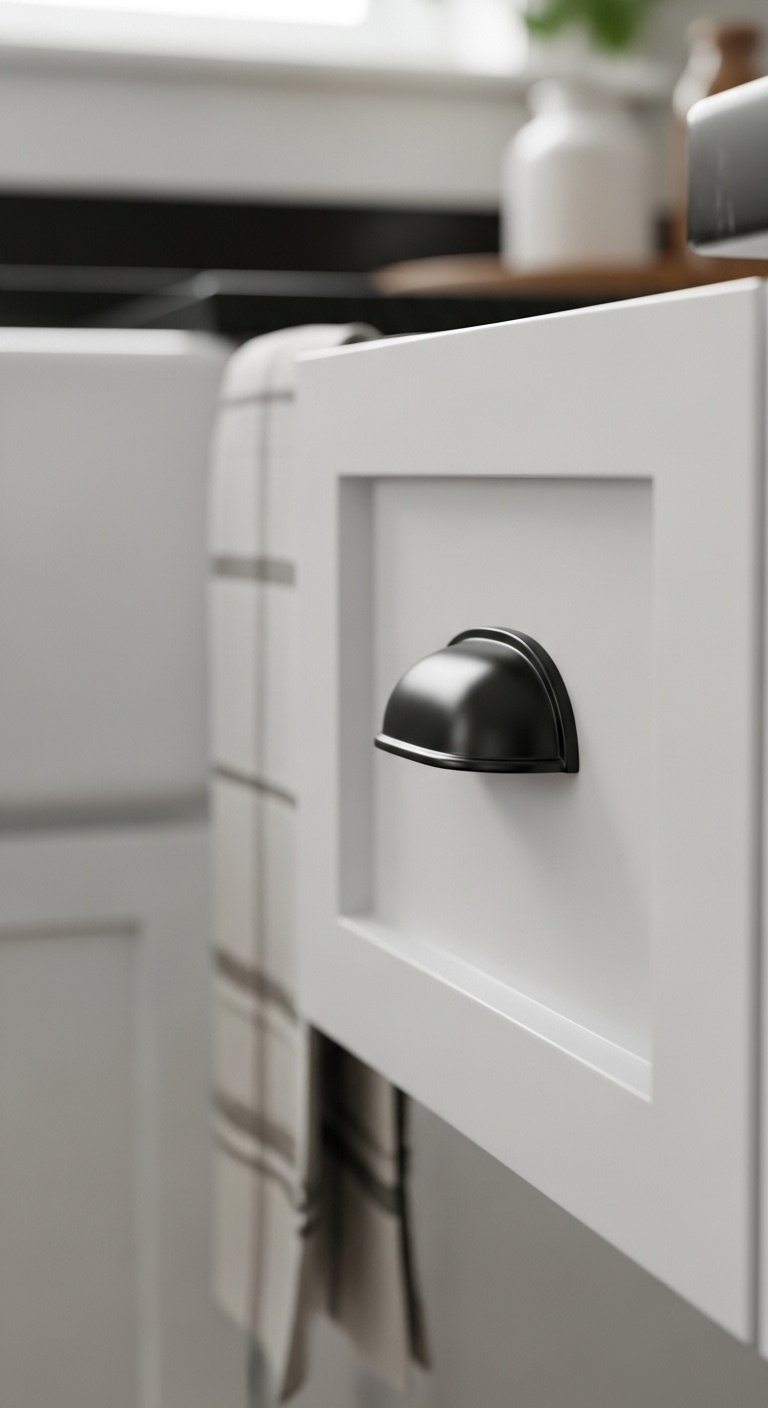
The perfect finishing touch! Pin this hardware idea now.
6. Decorate with Functional and Vintage Accents
A core tenet of the farmhouse aesthetic is to celebrate functionality by displaying beautiful, utilitarian items as decor. This approach creates a space that feels practical, lived-in, and effortlessly stylish. Instead of hiding everything away, the farmhouse kitchen puts its tools and wares on display, turning everyday objects into art.
Items like wooden cutting boards, stoneware dishes, and rustic wooden utensils can be beautifully displayed on countertops or open shelves. This is where you can truly inject personality by integrating thrifted or antique pieces. Look for things like vintage scales, old bread boards, or charming old signs to add a sense of history and character. These items contribute to the “collected-over-time” aesthetic that is central to the style. Finally, bring the outside in with fresh or faux flowers and greenery. A touch of green brings life and a connection to nature into the space, making it feel vibrant and fresh.
Actionable Steps (Creating a Countertop Vignette):
- Materials Needed: Various wooden cutting boards, a large ceramic crock or vase, wooden spoons/utensils, fresh or faux greenery.
- Step-by-Step Directions:
- Create a Base: Lean two or three wooden cutting boards of different shapes, sizes, and wood tones against your backsplash. This simple trick creates a layered, textured backdrop for your vignette.
- Add Height: Place a tall crock or an interesting vase in front of the cutting boards to add vertical dimension.
- Fill with Function: Fill the crock with your most-used functional items like wooden spoons, a wire whisk, and a rolling pin. This keeps them handy and looks charming.
- Bring in Life: Complete the arrangement by adding a small potted herb like basil or a small vase with a few stems of eucalyptus. This touch of green adds life and a pop of natural color.
Pro-Tip: The key to achieving that authentic “collected-over-time” look is variation. I always advise making a habit of visiting local thrift stores and antique shops once a month. You don’t need to buy something every time, but it’s the absolute best way to find unique pieces with genuine character that you simply can’t get from a big-box store.
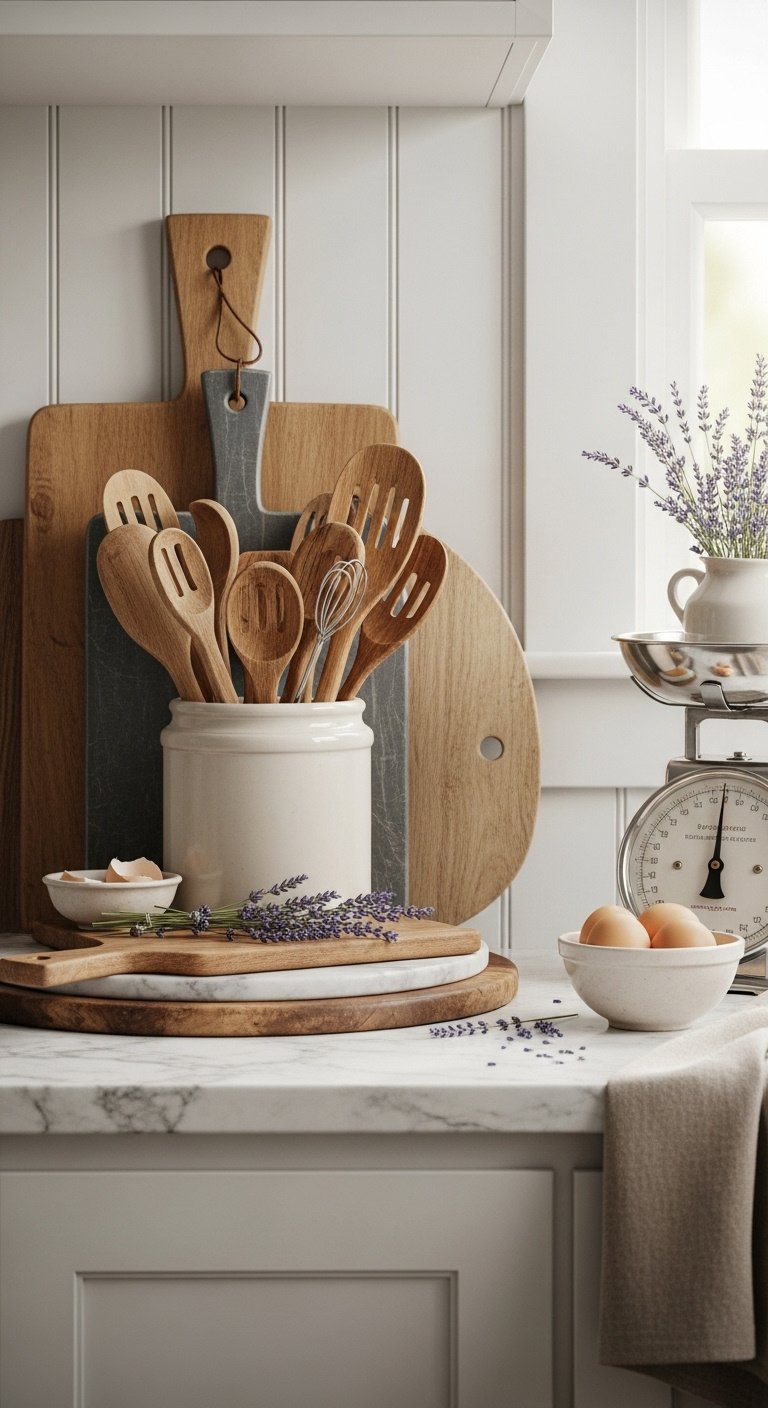
Get this charming, lived-in look! Save this pin for later.
7. Select a Classic, Textured Backsplash
A well-chosen backsplash can tie the entire kitchen together, and for a farmhouse style, you should choose a classic material that adds subtle texture and character. The backsplash is a great opportunity to reinforce the rustic charm of your space without overwhelming it. There are several classic options that work perfectly.
Subway tile is a versatile and timeless choice, especially in a classic white or off-white. It provides a clean, bright backdrop that complements nearly any other design element. For a modern twist, you could consider a handmade ceramic tile with slight variations in color and texture for a more authentic, crafted feel. For a cozier, more cottage-like vibe, beadboard paneling is a wonderfully charming and budget-friendly option. And for a truly rustic and warm statement, an exposed brick or thin brick veneer backsplash adds incredible texture and a sense of history.
Actionable Steps (Choosing Your Backsplash):
- Materials Needed: N/A (This is a selection guide).
- Step-by-Step Directions:
- For a Timeless Look: You can’t go wrong with classic white 3×6 inch subway tile. For a more modern take, consider a slightly larger format or a handmade tile that features subtle imperfections and a slightly undulating surface.
- For a Cozy, Cottage Feel: Beadboard paneling is a fantastic budget-friendly and charming option. Paint it a crisp white for a clean look, or a soft, creamy off-white for extra warmth.
- For a Rustic, Industrial Edge: An exposed brick or thin brick veneer backsplash introduces incredible warmth and texture. This option pairs beautifully with both white and natural wood-tone cabinets.
- Consider Grout Color: Don’t underestimate the power of grout! The color you choose can dramatically change the final look. White grout on white tile creates a clean and seamless appearance, while a contrasting gray or dark grout will make the tile pattern pop and stand out.
Lesson Learned: If you choose a real brick or stone backsplash, make sure it is properly sealed. This is a critical step in a kitchen environment. A quality sealer will protect the porous material from grease splatters and food stains, making it much easier to wipe clean and maintain over time.

Pin this timeless backsplash idea for your kitchen inspiration!
8. Center the Room with an Island or Farmhouse Table
The centerpiece of a farmhouse kitchen should be a substantial island or a large, rustic table that acts as a central gathering point. While modern kitchens often feature built-in islands, traditional farm kitchens historically used large work tables. Incorporating either of these provides a hub for cooking, conversation, and family meals.
A large, rustic farmhouse table is a fantastic choice, especially in eat-in kitchens, as it fosters a warm, communal atmosphere. If you need more storage and prep space, an island is the better option. To maintain the authentic farmhouse feel, choose an island with features that make it look more like a piece of furniture—such as turned legs, open shelving on the ends, or a base painted in a contrasting color to the main cabinets.
Actionable Steps (Choosing Your Centerpiece):
- Materials Needed: N/A (This is a selection guide).
- Step-by-Step Directions:
- Assess Your Needs: First, determine your primary need. Do you require more prep space and hidden storage? A built-in island is your best bet. Are you looking for a casual dining and gathering spot for family and friends? A large farmhouse table is a more traditional and inviting choice.
- Embrace the Furniture Look: If you opt for an island, choose one with legs, open shelving, or a contrasting color on the base. These details help it feel more like a piece of freestanding furniture rather than a block of cabinets.
- Prioritize Flow: Proper clearance is essential for a functional kitchen. Ensure you have at least 36-42 inches of open space on all sides of your island or table to allow for comfortable movement and easy access to appliances.
- Get Creative: Don’t be afraid to use a repurposed piece for a unique touch. A vintage workbench, an old drafting table, or a sturdy console table can be transformed into a character-filled island, especially for a smaller kitchen.
Pro-Tip: For maximum versatility in an eat-in kitchen, consider a counter-height farmhouse table instead of a standard dining height one. This clever choice allows it to double as both an informal eating area and an extra food prep surface when you’re cooking for a crowd.
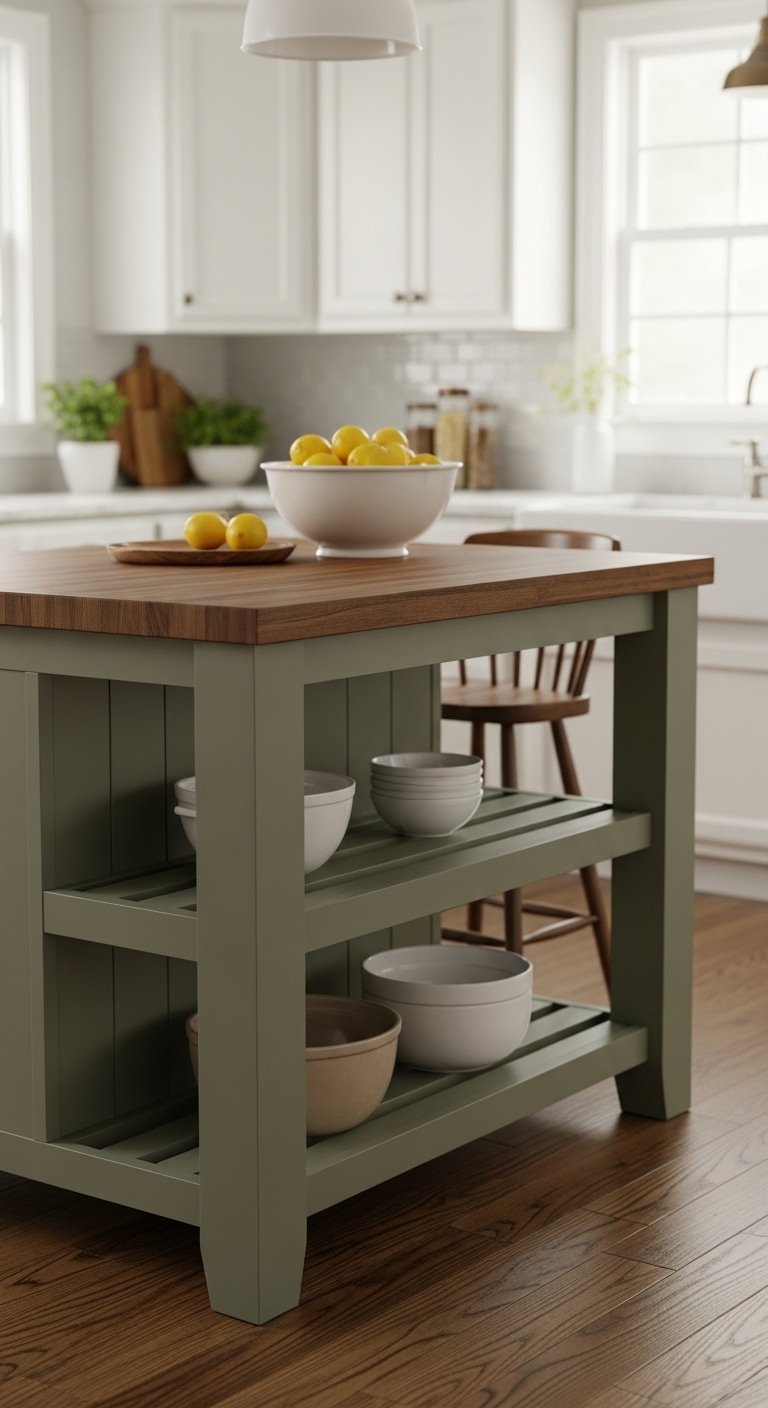
The perfect centerpiece! Save this island inspiration now.
9. Add Character with Architectural Details
To truly solidify the farmhouse aesthetic, incorporate architectural elements like shiplap, beams, or barn doors. These details provide texture and significant visual interest, reinforcing the rustic charm of the space and making it feel custom and thoughtfully designed. Even in a new build, these features can add an immediate sense of history and character.
Shiplap walls are a hallmark of the style, adding clean, horizontal lines and a subtle texture. Ceiling beams—whether they are authentic reclaimed wood or lightweight faux versions—draw the eye upward and add incredible warmth and architectural drama. A sliding barn door on a pantry or adjoining room is another popular feature that is both functional and a powerful design statement.
Actionable Steps (Installing Faux Beams):
- Materials Needed: Faux wood beams (lightweight polyurethane), high-strength construction adhesive, drill, screws, wood filler or caulk.
- Step-by-Step Directions:
- Measure and Cut: Carefully measure the length of your ceiling where the beams will go. Cut the lightweight faux beams to size using a hand saw or miter saw.
- Apply Adhesive: Run a generous bead of high-strength construction adhesive along the top edges of the beam that will make contact with the ceiling.
- Position and Secure: Press the beam firmly into place on the ceiling. For extra security and peace of mind, drive screws through the beam directly into the ceiling joists.
- Finish the Seams: Use a paintable wood filler or caulk to seamlessly cover the screw holes and any joints between beam sections for a polished, professional look.
Lesson Learned: Shiplap offers more versatility than you might think. It can be installed horizontally for that classic, expansive look, or installed vertically to create the illusion of taller ceilings, which is a great trick for smaller spaces. For a modern take, try painting it a moody color like charcoal gray or dark green instead of the traditional white.
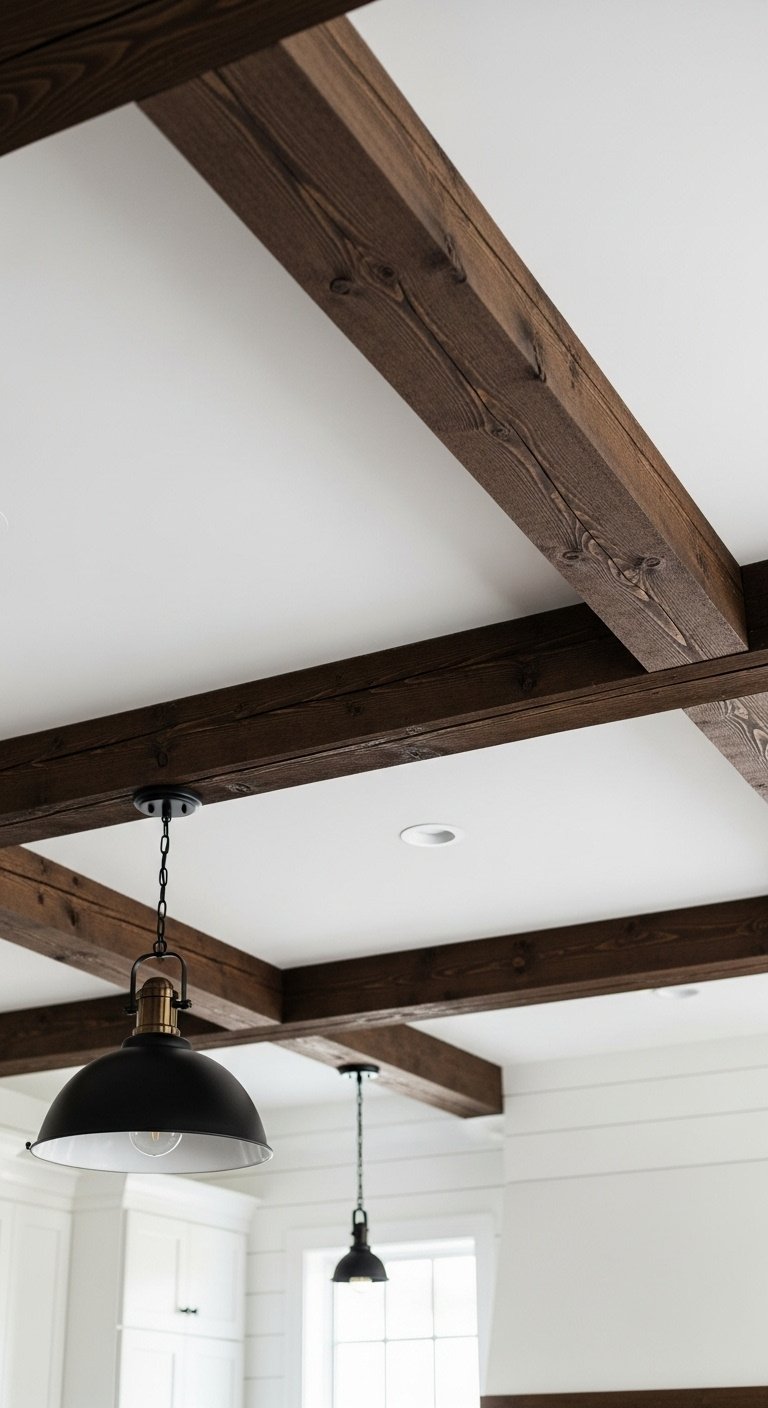
Add instant character! Pin this ceiling beam idea.
Key Takeaways: Your Quick Guide to a Charming Farmhouse Kitchen
Feeling inspired? Creating your dream farmhouse kitchen is entirely within reach. By thoughtfully combining these core elements, you can design a space that is both beautiful and highly functional, reflecting a timeless sense of warmth. Here are the most important principles to remember:
- Focus on a Neutral Foundation: Start with a base of whites, creams, and grays. This creates a calm, versatile backdrop that allows other elements to stand out.
- Layer Natural Textures: This is non-negotiable. Incorporate plenty of wood, stone, brick, and woven fibers to add the essential warmth and character that defines the style.
- Blend Old and New: The magic is in the mix. Combine modern conveniences and clean lines with vintage-inspired elements like an apron-front sink and classic hardware.
- Prioritize Functional Decor: Let your beautiful, everyday items double as decor. Display cutting boards, pottery, and utensils to create a lived-in, authentic feel.
- Details Matter: Don’t overlook the power of architecture. Elements like shiplap, ceiling beams, or a barn door provide the perfect finishing touch that solidifies the entire look.
People Also Ask About Farmhouse Kitchen Ideas
You have questions, and we have answers. Here are some of the most common queries people have when considering a farmhouse kitchen design.
Is farmhouse decor still in style in 2025?
Yes, but it has evolved. The “modern farmhouse” style is still very popular in 2025. It moves away from “cliche” decor like excessive word art and focuses on a cleaner, more sophisticated look with natural materials, neutral colors, and authentic vintage pieces. It’s about timeless comfort, not fleeting trends.
What trend is replacing farmhouses?
While no single trend is “replacing” farmhouse, styles like “Cottagecore” and “Warm Minimalism” share some of its DNA. Cottagecore is a more romantic, whimsical version with more patterns and florals. Warm Minimalism focuses on clean lines and natural materials but with fewer rustic details. Many homeowners are simply blending these elements into their modern farmhouse aesthetic for a personalized look.
What kitchen style never goes out of style?
A well-designed kitchen that prioritizes functionality, quality materials, and a neutral color palette is always timeless. Styles like Shaker, with their simple and clean lines, have been popular for centuries for this very reason. A classic white kitchen, layered with natural elements like wood and stone, will always feel fresh, relevant, and valuable.
How do I make my kitchen look farmhouse on a budget?
Focus on high-impact, low-cost changes. Start by painting your existing cabinets a fresh neutral color and updating the hardware—this alone can be transformative. Incorporate decor from thrift stores, like vintage cutting boards, crocks, and art. Add affordable open shelving instead of expensive new upper cabinets, and consider a DIY project like a beadboard backsplash.
Final Thoughts
Creating a farmhouse kitchen isn’t about following a rigid set of rules; it’s about crafting a space that feels uniquely yours—a space that is personal, warm, and deeply welcoming. It’s about building a backdrop for your life’s best moments. By embracing natural materials, celebrating functional beauty, and mixing in pieces that tell a story, you can design a kitchen that you will love for many years to come.
Which of these ideas are you most excited to try in your own home? Let us know in the comments below
